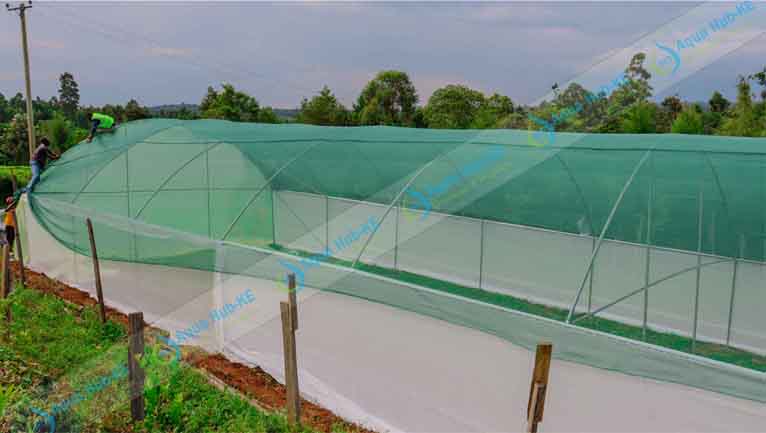Shade Net Farming for Vegetables

The birth of innovation in agriculture has found a major way to better production even in unfavorable conditions. Shade net farming in Kenya is a way to moderate temperatures at extremely hot places for optimal vegetable and other crop cultivation.
Properties
- Shade Netting materials contain UV matter in their compounds. UV materials are resistant to harsh solar degradation.
- Highly durable due to strong HDPE materials make
- Serves a Wide range of applications including crop farming, car shading, fish pond protection and compound protection.
- Sunlight filtration levels; 35%, 55%, 75% and 90%.
- Standard rolls come at dimensions of 4 x 50 M.
- Available in black and green colors.

Cost of Shade Nets in Kenya
Shade nets are available in prices that differ with sunlight filtration levels. Aqua Hub Kenya gives you value for your money through quality Shade net farming materials.
Total cost of shade net farming will also depend on the size of the shade net structure you want to set up. Sizes may vary as per your desire or farm size ranging from 8 x 15 to custom large sizes.
The cost of full rolls depend on sunlight filtration rate;
- 35 % – 14,000
- 55 % – 20, 000
- 75 % – 26,000
- 90 % – 36,000
Shade Nets are Important ; Find Out Why
The materials for shade netting works well, as the design allows sunlight, air, and water.
The use of shade nets aims at minimizing sunlight intensity that comes in contact with plants and the crop root zones. Therefore, crops cannot strain to acquire sufficient moisture for growth as the soil remains hydrated.
Shade netting is a measure to promote continuous crop growing in dry seasons. The minimal water is utilized to irrigate and produce vegetables which attracts high demand and price due to scarcity.
Setting Up Shading Nets
The activities of setting up your shade net farming structure unfolds once you know what net type you need. Arriving at the decision of the net to use often requires assessment of crops to grow, cost, suitable net and structure type.
The primary consideration is the crop type or sunlight requirement which determines what net percentage is for you.
Cost of the nets also limits you on what you get and the population of crops you can cultivate.
Any Structure works but a metallic structure will serve you for a longer time. For a wooden structure, the cost will be lower and favorable for small scale and entry level growers.
How to Set Up Shade Net Farming Structures
There are various ways you can set up and install a shade net over your crops. Proper ways include draping the net over the crops, fixing it on a wooden structure or attaching it on a metallic fabricated structure.
Shade Net Installation on a Wooden or Metallic Structure
- Choose and Set aside a good area to place you shade net material. Choosing will be based on soil drainage, land topography and soil fertility.
- If there is thick bushes, clear and burn and get rid of them.
- Cultivate the land and break the soil loose to enhance easier propagation.
- Measure and make holes for laying support poles. The holes should be 30 cm deep and 3 M apart.
- Erect wooden poles or steel poles and fill the holes with cement, sand and ballast for firm support.
- Attach roofing poles using nails(wooden structures). Attach arc-shaped roofing poles using tapping screws (metallic structure)
- Spread the netting over the roof to cover the entire structure and attach it using wires.
What to Grow Under Shade Nets
Vegetables
Shade net farming supports the production of kales, indeterminate tomatoes, garlic, cabbages and lettuce. Most vegetables require a shade net percentage of 35 – 55 % for proper temperature and weed control.
Flowers
Certain variety of flowers can be grown under shades in most hotter regions of Kenya such as Naivasha. Shade net farming enhances Production of fresh roses, carnations, pyrethrum, and Chrysanthemums.
Herbs
Certain herbs such as cilantro, dill, parsley, mint, thyme, chives and green onions love growing in shade.
You require a netting material of 75-90 % to provide maximum cooler conditions for growth of herb varieties.
Seedlings

Tree, fruit and vegetable seedlings are protected when grown under cool shade houses.












